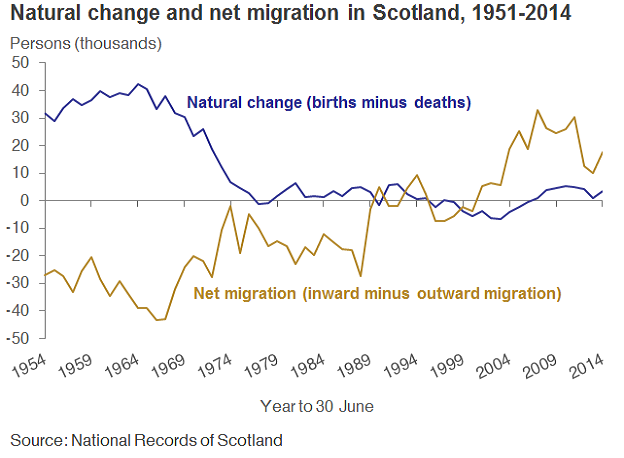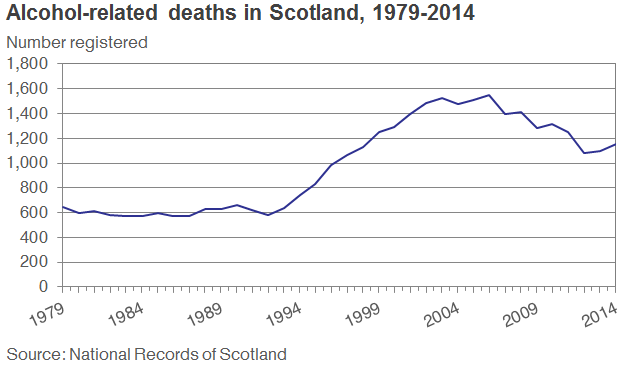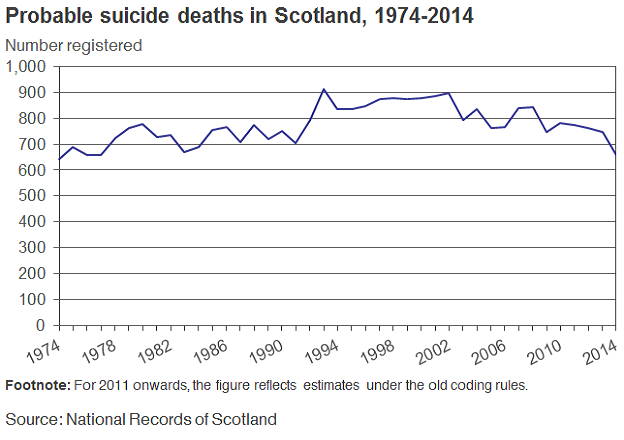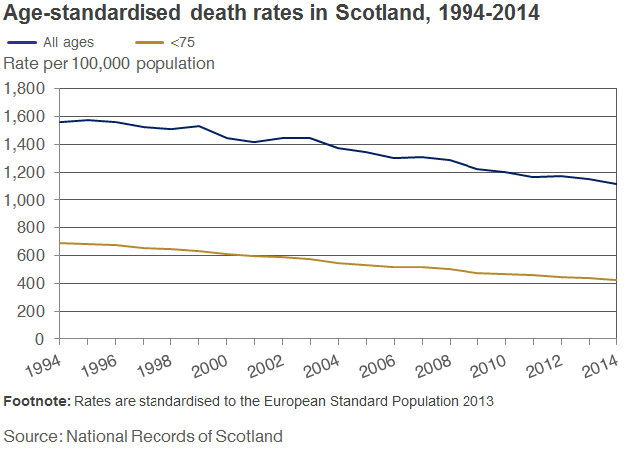Scotland’s Changing Population
Scotland’s Changing Population

Demographic information about Scotland’s population
National Records of Scotland (NRS) today publishes Scotland’s Population 2014 – the Registrar General’s Annual Review of Demographic Trends.
Tim Ellis, the Registrar General of Scotland, said:
"This is a time of substantial demographic change: the population is increasing and ageing. The ageing population is the most distinctive current demographic development and will bring both opportunities and challenges.
Life expectancy at birth in Scotland, while increasing, is lower than in the UK as a whole, and lower than a lot of other developed countries. There is also considerable local variation in life expectancy. Good quality data contributes to research aimed at improving the quality and cost-effectiveness of health interventions, and securing lasting improvements to the health of the people of Scotland.
In the last half of the 20th century, more people tended to leave Scotland than move here. However, since 2001, this has changed, with more people moving to Scotland than leaving. Around 60 per cent of people moving to Scotland are from the rest of the UK, while around 40 per cent are from overseas. Migrants tend to be younger than the population as a whole."

The report on Scotland’s Population shows that:
- The estimated population of Scotland on 30 June 2014 was 5,347,600, the highest ever recorded.
- Life expectancy in Scotland has improved greatly over the last 30 years. Life expectancy of those born around 2013 is now 77.1 years for males and 81.1 years for females. This is an increase of 8 and 5.8 years respectively. However, life expectancy in Scotland has improved more slowly than in the rest of the UK and elsewhere in Europe.
- In the year to 30 June 2014, 82,440 people came to Scotland (from the rest of the UK and from overseas) and 64,860 left Scotland (to the rest of the UK and overseas). This resulted in a net-gain of 17,580.
- There were 29,069 marriages in Scotland in 2014. Of these, 367 were same-sex marriages following The Marriage and Civil Partnership (Scotland) Act 2014 coming into force on 16 December 2014. There were also 436 civil partnerships – 193 male couples and 243 female couples. The average age at which people marry for the first time has increased by around two years since 2004, to 33.2 years for men and 31.4 years for women in 2014.
- There were 56,725 births registered in Scotland in 2014. There were 711 (1.3 per cent) more births in 2014 than in 2013. This is the first rise following five consecutive annual decreases in the number of births.
- There were 54,239 deaths registered in Scotland in 2014. The top causes of death were cancer (15,840), ischaemic (coronary) heart disease (6,872), respiratory system diseases (6,707), and cerebrovascular disease (stroke) (4,123).
- In 2014, there were 455 adoptions recorded in Scotland. The number of adoptions each year is around a quarter of what it used to be in the early 1970s.
- In mid-2014, there were 2.42 million households in Scotland, which is an increase of around 169,000 over the past ten years.
The report also contains an invited chapter analysing how Scotland’s ethnic groups fare in the labour market. The analysis shows that:
- People of Polish ethnicity in Scotland were the most economically active, but they were most likely to be in lower-skilled employment;
- Those of Indian ethnicity were the most likely to be highly qualified and working in the top professions;
- Gypsy/Travellers were more likely than other ethnic groups to be working the longest hours, and to be in the lowest social grade.
The report is a compendium that brings together key demographic information from a range of publications produced by NRS. It has been produced annually since it was first published in 1855. It is accompanied by an update on a wide range of other statistics on births, stillbirths, adoptions, marriages, civil partnerships and deaths, which appear in the Vital Events Reference Tables and in website sections on deaths from certain causes.
Among the other information published by NRS today:
- There were 1,152 alcohol-related deaths in 2014, an increase of 52 (5 per cent) compared with 2013;

- There were 696 probable suicides in 2014, 99 (12 per cent) fewer than in the previous year;

- Age-standardised death rates fell by 19 per cent between 2004 and 2014 for all ages and by 23 per cent for people aged under 75.

The full publications Scotland's Population 2014 - The Registrar General's Annual Review of Demographic Trends, Vital Events Reference Tables 2014 and Deaths by various causes (excluding Drug-related Deaths and Winter Mortality) are available on this website.
An infographic report on Scotland’s population, along with interactive data visualisations on causes of death and birth rates by age has also been published today on this website.